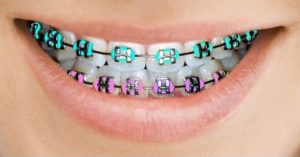
Many people associate white and uniform teeth with health and beauty. However, if your teeth are not rights by nature, you can consider using brackets for cosmetic reasons as well as to treat medical problems. But do you know if your teeth could benefit from braces? Do you know if you need them? Here are some simple steps you can follow to find out.
Examine your teeth
See if your teeth are crowded or crooked. These are known as malocclusions. The warning signs are, among others: teeth that look as if they were on one side, teeth that overlap each other and teeth protruding significantly beyond the neighboring teeth. Bonding is the most common problem treated by brackets.
To determine if your teeth are crowded, you can floss. If it is very difficult to floss between your teeth, perhaps it is because they are crowded too close to each other.
Understand how malocclusion can affect you:
The crowded teeth or too close can hinder, even for professionals in dentistry, proper cleaning. The formation of plaque on the teeth can cause abnormal wear of the enamel, decay, and gingivitis.
Many things can generate the appearance of crooked or crowded teeth. For some people, their mouths are simply too small to hold their teeth properly, which causes them to move and huddle. Other people may have crowded teeth once their wisdom teeth come out you can know more details from here www.alignbeautyorthodontics.com.
Other people can clump their teeth once the wisdom tooth comes out because it makes the teeth look crooked because the roots and bone support weaken.
See if your teeth look too far apart:
The agglutination is not the only situation that can bring problems. If you have missing teeth, proportionally small teeth or large gaps between the teeth, it could also prevent the functioning of your bite and your jaw. Spacing is one of the most common problems solved by braces.
Analyze your bite:
Your teeth should fit when you bite. If there is a large space between your upper and lower teeth, or if your upper or lower teeth overlap much, you may have bite problems that need to be corrected with braces.
Upper teeth that extend beyond the lower teeth when biting can cause an overbite.
Lower teeth that extend beyond the upper teeth when biting can cause a sub-bite.
There is also another case where, when biting, your lower front teeth do not touch the upper ones, which leaves a sagittal space.
The upper teeth that are poorly placed inside the lower teeth cause a crossbite, which if not corrected can lead to facial asymmetry.
Understand how to bite problems can affect you:
If the bite is misaligned, the chances of having a plaque or the formation of decaying food particles on or between the teeth increases. This plaque and decaying food can cause periodontal diseases, gingivitis, tooth abscesses, and even tooth loss.
Misaligned bites can also cause difficulties when chewing, which can cause inflamed jaws and even gastrointestinal discomfort.
Misalignment in the jaw can cause contraction of muscles, which in turn can cause frequent headaches.
Excessive overbites can cause lower teeth to damage the gingival tissue on the palate.
Take other symptoms into account
Determine if food gets stuck in your teeth. Having food between your teeth routinely can create a shelter for bacteria that can cause gingivitis and tooth decay. Brackets can help eliminate gaps or holes between teeth that trap bacteria and food particles.
Smell your breath. Frequent or persistent bad breath, even after brushing or flossing your teeth, can be a sign that bacteria are trapped between crooked or crowded teeth.
Listen when you speak. In the event that you see a stutter, it might be the consequence of malocclusion or misaligned teeth. Brackets can help eliminate this lisp by aligning the teeth and jaw.
Consider if your jaw hurts often. If your jaw is misaligned, it could put extra pressure on the temporomandibular joints, that is, the hinges that connect the jaw to the head. If you experience inflammation or frequent pain in this area, you may need braces to align your jaw.
Consider the idea of putting braces
Think about why you want to put on braces. There are many reasons why people choose to use braces. Sometimes, it’s just a cosmetic decision. Many people associate right and white teeth with health and beauty, and there is nothing wrong with wanting a pearly white smile. However, there are also medical reasons to consider the use of braces.
Misalignment of the bite and malocclusion (crooked or crowded teeth) is the most common medical reasons for braces.
Determine your willingness to live with braces. If you are an adult, you will need to use braces for a period of almost 12 to 20 months on average. Most children and adolescents need braces approximately 2 years most likely you will also need to use a retainer several months after removing your braces. Adults may have to wear braces longer than small children or teens. In addition, since adults’ facial bones have already stopped growing, braces cannot correct certain conditions in adults (such as sleep apnea) that they can correct in children.
Talk to friends who have braces. Especially if you are an adult and have never worn braces, hearing the testimony of someone who has used them can help you determine if they are right for you.
Decide if you can afford the brackets:
The standard metal brackets usually have a fairly high price. More specialized brackets, such as transparent ceramic or “invisible” brackets (such as Invisalign), are usually even more expensive.
Some health insurance plans do not cover the use of braces. Check your dental coverage and the additional expenses with your insurance provider.
Talk to your dentist about your teeth:
While dentists do not have specialized training like orthodontists, they will give you a good first opinion about your teeth. A dentist can help you decide if you should see an orthodontist by your teeth and jaw.
Your dentist can also refer you to a reliable orthodontist in your area.
Ask your dentist about aesthetic veneers:
If your teeth are not crooked enough or cluttered enough to use braces to re-align them, then aesthetic veneers may be the best option for you. Aesthetic veneers are thin porcelain sheets that are glued to the front of the teeth to improve their aesthetic appearance and offer instant results.
Consider the idea of putting braces
Ask your dentist about braces:
Your dentist can take X-rays and perform bite tests that will help determine if you need to see an orthodontist.
Your dentist will also tell you if your teeth are crowded or just a little bit stuck together.
Check with your orthodontist
The American Orthodontic Association maintains an online database of orthodontists authorized by the AAO, which includes a search function to find one in your area. You can ask for a referral to your regular dentist.
Know the types of brackets available:
The days of the horrific headdresses and the “metal mouths” have been left behind. Depending on your budget, you’re dental needs and your aesthetic preferences, you can choose from a wide variety of braces.
In general, standard metal brackets are usually the least expensive and the most effective option. However, some people may be self-conscious using very bright braces.
Transparent ceramic brackets adapt to the front of the teeth like metal brackets, but they are less flashy. They are a little less effective, more prone to stain and break. In general, they also cost more than metal ones.
Invisible braces are quite different from traditional braces. The most common type of invisible braces is Invisalign. Invisalign braces are a series of custom aligners that are used to move the teeth gradually into place. Since you have to buy sets of multiple aligners to move the teeth gradually, Invisalign brackets are the most expensive option. Also, they do not work well to treat bite problems.
Get some information about any dangers related to props:
For almost everyone, using braces is a safe procedure, although sometimes uncomfortable. However, there are some associated risks, so ask your dentist for more information.
In the case of some people, the brackets can cause loss of the length of the dental roots. Although this almost never presents problems, in some cases it can leave the teeth unstable.
If your teeth have been damaged before as a result of physical trauma or an accident, the movement of the tooth generated by the brackets could cause discoloration or irritation in the nerve of the tooth.
If you do not follow the orthodontist’s instructions, your braces may not correct your teeth in an expected way. They may also not correct you completely after removing your braces.
Ask your orthodontist about proper oral hygiene:
If you decide to wear braces, you will have to take additional measures to prevent gingivitis, cavities, and decalcification.
Keep in mind that it is much more difficult to clean your teeth properly when you have braces, especially if they are made of metal or transparent ceramic that are attached to your teeth.
Tips
Brush your teeth after every meal (breakfast, lunch, dinner) if you need braces.
Braces are expensive, but some orthodontists accept payments in installments instead of wanting all the payment at once. Before applying braces, ask for a payment plan.




